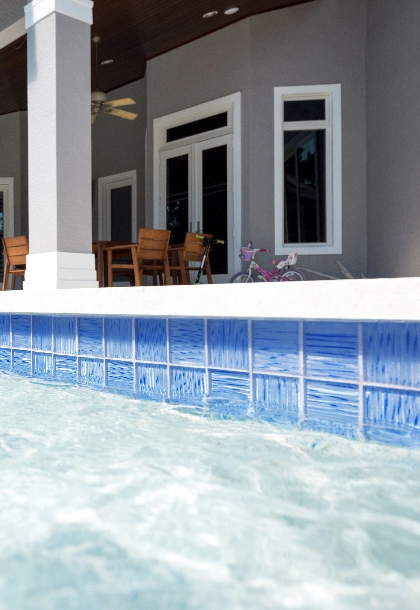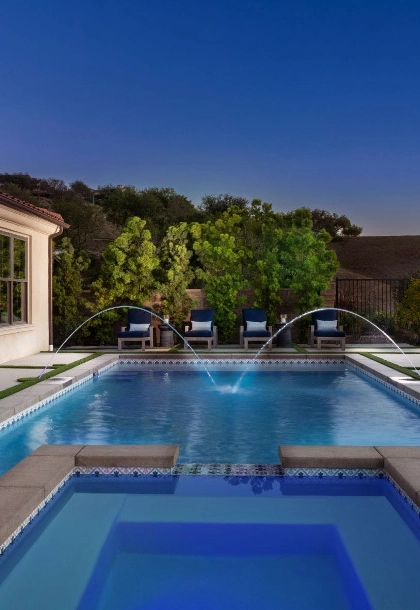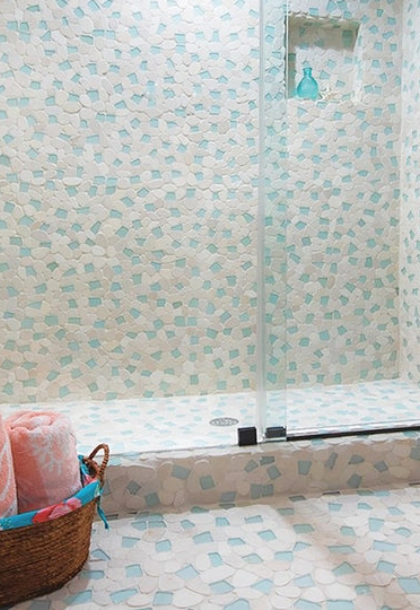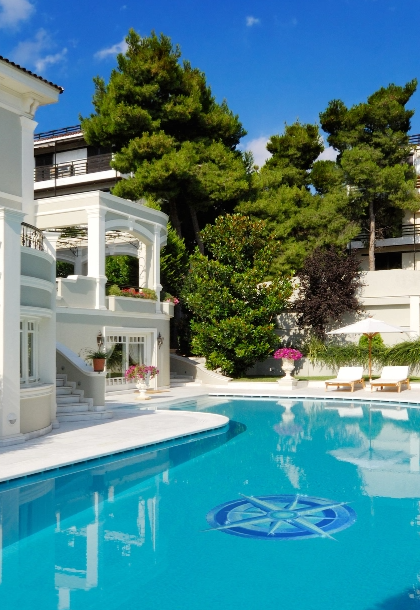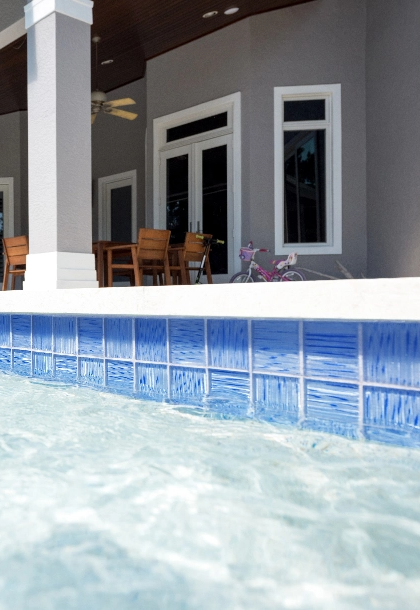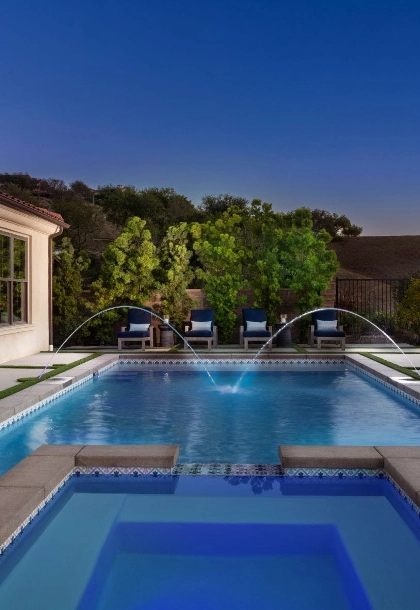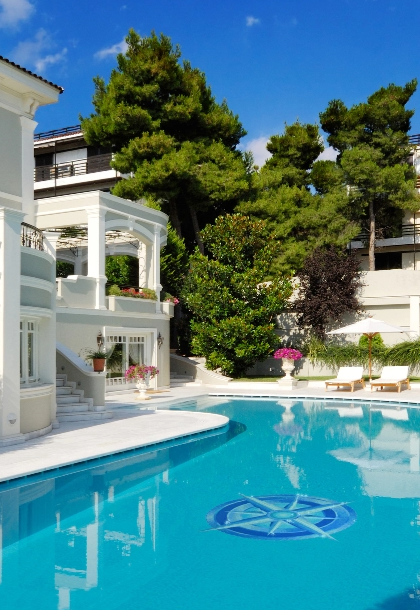Glass Tile vs. Porcelain Tile - Do You Know the Difference?

While porcelain and ceramic tile may still be the most popular choice for indoor and outdoor applications, glass tile is rapidly closing in as a design choice for backsplashes, counter tops, interior walls and swimming pools.
But how much do you really know about what separates these attractive tile choices? First off, it’s important to understand the difference between porcelain tile and ceramic tile. These two terms are often used interchangeably – but they are more like cousins than identical twins.
The main difference between a porcelain and ceramic tile is the rate of water they absorb. Porcelain tiles absorb less than 0.5% of water while ceramic and other non-porcelain tiles will absorb more. This makes porcelain tile a better choice for use around water such as for pools, backsplashes and showers.
This difference in absorption is due to the materials used to make porcelain tiles. Porcelain tile is made from clay and other natural materials blended together and fired in a furnace. It’s known for being highly uniform in construction and non-porous.
Generally, porcelain tile comes in the same thicknesses as ceramic tile, but it is heavier overall. It is also offered in more shapes and styles than ceramic tile.
The advantage of ceramic over porcelain tile is that it’s less expensive and easier to cut and shape because it’s softer.
Glass tile on the other hand is a totally different animal. Glass tiles are made through a variety of production methods, however the three of the primary types are: cast glass, fused glass, and sintered. Glass mosaic tiles are commonly pre-mounted in mosaic patterns either on the face of the tile, or on top of a mesh backing. Glass tile’s surging interest in recent years is greatly due to the reflective quality of glass and how it can brighten a pool or dull interior space as well as the ease of maintenance.
Here’s a closer look at some of the pros and cons of glass tile vs. porcelain tile:
Glass Tile vs. Porcelain Tile: Appearance
Aesthetically, glass tile wins this one. Porcelain tile is no slouch in the looks department either. Made from high-quality components, porcelain tiles have the ability to transform your space into something you are truly proud of. However, porcelain (like ceramic) is opaque, which means all its color is on the surface.
Many glass mosaic tile products are translucent, allowing light to penetrate the entire tile or reflect off the tile surface. The translucence of glass gives the tile visual depth, and it gives the overall tile color a beautiful watery shine or glow. For those not looking for a translucent glass tile, you're in luck - there are also many options of opaque glass mosaic tiles to choose from as well. Opaque glass tiles are created by heating and pressing colored glass powder into sheets, which gives the tile a through-color effect.
Both glass and porcelain tile are now available in a vast array of patterns, colors and sizes. For those looking for something with a rainbow-like appearance, consider glass iridescent tile for your project.
Durability of Glass Tile vs. Porcelain Tile
One of the most important qualities of porcelain tile is its durability and resistance to wear. That’s because porcelain has fewer air pockets. It’s a denser material and more uniform in construction and tends to be harder and thicker overall than most other tile varieties.
Porcelain tile floors, for example, are known to last for years, and they are a top choice for commercial use or in rental properties because of just how durable they are over time. If you want flooring that will hold up to pets well and continue looking good for years, that’s one of the biggest benefits that you’ll enjoy. Porcelain is scratch resistant and less prone to breaking. In the swimming pool world, 6" x 6" porcelain waterline pool tiles have been the industry standard for decades.
Glass tile may be susceptible to chips and scratches over time. But a lot of this depends on the quality and thickness of the glass, as well as where it is installed.
Glass can also be slippery in some applications. That’s why some people who install glass floors use a matte finish tile or slip resistant glass tile for more traction. In addition, utilizing small glass tiles is a good option for floors as the larger number of grout joints will increase the overall coefficient of friction of the surface. When installed correctly, glass tile will undoubtedly withstand the test of time.
Glass Tile vs. Porcelain Tile Installation
Both porcelain and glass are typically labor-intensive because of the hardness of porcelain and splintering possibility of glass. Of the two, glass has a more complex installation process so it is recommended that you hire a professional, which may be an extra cost for you. Keep in mind the mounting type of the mosaic tile product you choose as some tile installers either prefer to work exclusively with face-mounted or mesh-mounted tile.
The experts recommend four tools for cutting glass tile:
- A wet saw
- A manual scoring wheel
- A bar cutter
- Wheeled mosaic nippers
Glass Tile vs. Porcelain Tile Maintenance
Both glass and porcelain tile are easy to maintain and have a long life span.
Porcelain tile doesn’t harbor bacteria like more porous material does, and it’s very simple to wipe off and keep clean over time. The tile stays cleaner than traditional ceramic tile and doesn’t suffer from staining as easily. Home owners will love how easy it is to keep porcelain tile looking good.
Glass tile is impervious to liquids and resistant to staining and discoloration, which means cleaning generally only requires a simple wipe down. If you dislike mold with a passion then this is a great choice for your bathroom or swimming pool. But be careful! Although glass may not develop mold, the grout may. Smart shoppers should refrain from using cheap cement-based tile grout and opt for a more waterproof, stain-resistant epoxy tile grout. Using glass mosaic tile as a swimming pool finish with epoxy grout is a "forever" solution when compared with plaster or gunite, providing customers with the longest lasting finish and easiest maintenance.
Glass Tile vs. Porcelain Tile Cost
Glass is generally more expensive than porcelain, but it’s difficult to get a handle on installation costs. These vary dramatically from ZIP code to ZIP code. That said, expect to pay an average installation cost of $10 to $30 per square foot. Of course price will also be highly dependent on volume, so be sure to get a quote from several installers before making any commitments.
On average, porcelain pool tiles start as low as $4 per square foot while glass starts at $6 - $8 per square foot. Premium porcelain or glass tile mosaics can be anywhere in the $20 - $30 range.
For pool applications, the recent trend of glass tile pools is becoming more and more affordable, however if glass is over your budget, you may want to consider using glass mosaic tile for your pool waterline instead. In a kitchen or shower, you can use glass tile as an accent rather than covering large surface areas. Using glass as an accent will also help colorful mosaic blends from overwhelming the room.
-------
Want to know more about glass vs. porcelain tile? Or maybe there’s something else on your mind. Talk to one of our experts. You can call us at (800) 971-1442 or fill out our contact form. You can visit our website at https://www.aquablumosaics.com/.



